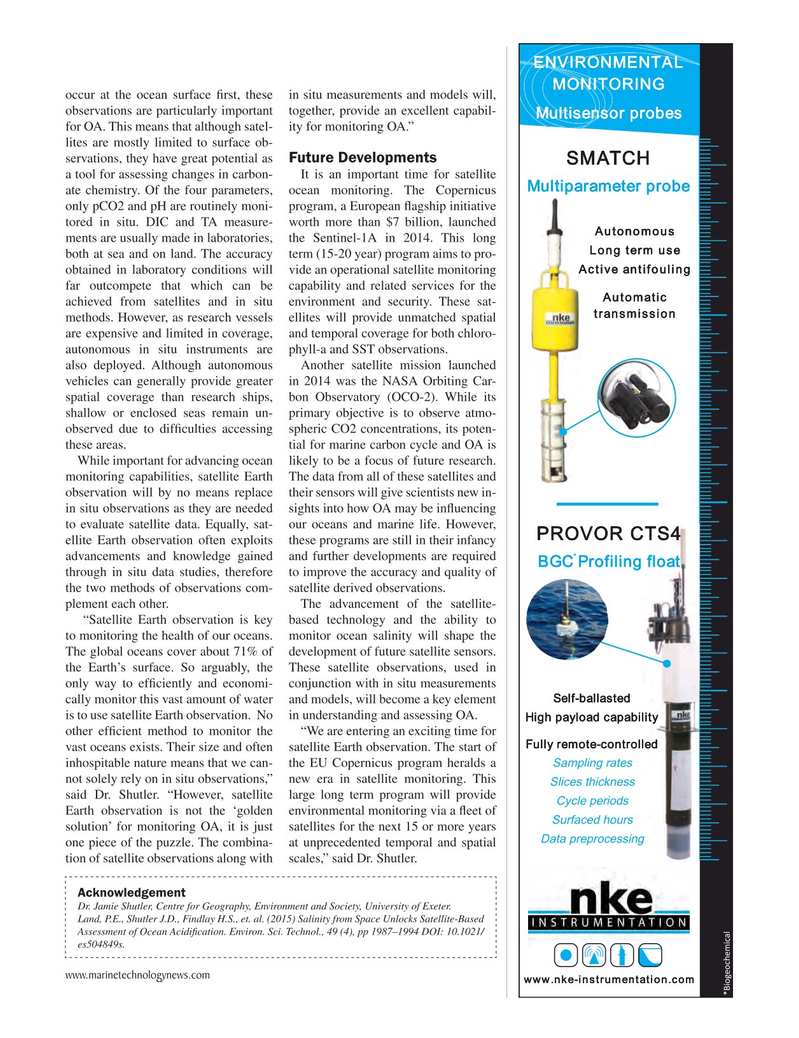
Page 37: of Marine Technology Magazine (May 2015)
Underwater Defense
Read this page in Pdf, Flash or Html5 edition of May 2015 Marine Technology Magazine
ENVIRONMENTAL
MONITORING occur at the ocean surface ? rst, these in situ measurements and models will, observations are particularly important together, provide an excellent capabil-
Multisensor probes for OA. This means that although satel- ity for monitoring OA.” lites are mostly limited to surface ob- servations, they have great potential as Future Developments
SMATCH a tool for assessing changes in carbon- It is an important time for satellite
Multiparameter probe ate chemistry. Of the four parameters, ocean monitoring. The Copernicus only pCO2 and pH are routinely moni- program, a European ?agship initiative tored in situ. DIC and TA measure- worth more than $7 billion, launched
Autonomous ments are usually made in laboratories, the Sentinel-1A in 2014. This long
Long term use both at sea and on land. The accuracy term (15-20 year) program aims to pro-
Active antifouling obtained in laboratory conditions will vide an operational satellite monitoring far outcompete that which can be capability and related services for the
Automatic achieved from satellites and in situ environment and security. These sat- transmission methods. However, as research vessels ellites will provide unmatched spatial are expensive and limited in coverage, and temporal coverage for both chloro- autonomous in situ instruments are phyll-a and SST observations. also deployed. Although autonomous Another satellite mission launched vehicles can generally provide greater in 2014 was the NASA Orbiting Car- spatial coverage than research ships, bon Observatory (OCO-2). While its shallow or enclosed seas remain un- primary objective is to observe atmo- observed due to dif? culties accessing spheric CO2 concentrations, its poten- these areas. tial for marine carbon cycle and OA is
While important for advancing ocean likely to be a focus of future research. monitoring capabilities, satellite Earth The data from all of these satellites and observation will by no means replace their sensors will give scientists new in- in situ observations as they are needed sights into how OA may be in? uencing to evaluate satellite data. Equally, sat- our oceans and marine life. However,
PROVOR CTS4 ellite Earth observation often exploits these programs are still in their infancy * advancements and knowledge gained and further developments are required
BGC Profiling float through in situ data studies, therefore to improve the accuracy and quality of the two methods of observations com- satellite derived observations.
plement each other. The advancement of the satellite- “Satellite Earth observation is key based technology and the ability to to monitoring the health of our oceans. monitor ocean salinity will shape the
The global oceans cover about 71% of development of future satellite sensors. the Earth’s surface. So arguably, the These satellite observations, used in only way to ef? ciently and economi- conjunction with in situ measurements
Self-ballasted cally monitor this vast amount of water and models, will become a key element is to use satellite Earth observation. No in understanding and assessing OA.
High payload capability other ef? cient method to monitor the “We are entering an exciting time for
Fully remote-controlled vast oceans exists. Their size and often satellite Earth observation. The start of
Sampling rates inhospitable nature means that we can- the EU Copernicus program heralds a not solely rely on in situ observations,” new era in satellite monitoring. This
Slices thickness said Dr. Shutler. “However, satellite large long term program will provide
Cycle periods
Earth observation is not the ‘golden environmental monitoring via a ? eet of
Surfaced hours solution’ for monitoring OA, it is just satellites for the next 15 or more years
Data preprocessing one piece of the puzzle. The combina- at unprecedented temporal and spatial tion of satellite observations along with scales,” said Dr. Shutler.
Acknowledgement
Dr. Jamie Shutler, Centre for Geography, Environment and Society, University of Exeter.
Land, P.E., Shutler J.D., Findlay H.S., et. al. (2015) Salinity from Space Unlocks Satellite-Based
Assessment of Ocean Acidi? cation. Environ. Sci. Technol., 49 (4), pp 1987–1994 DOI: 10.1021/ es504849s.
www.marinetechnologynews.com www.nke-instrumentation.com *Biogeochemical
MTR #4 (34-49).indd 37 MTR #4 (34-49).indd 37 4/30/2015 2:22:11 PM4/30/2015 2:22:11 PM

 36
36

 38
38
